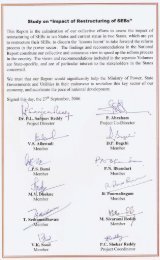Untitled - Ministry of Power
Untitled - Ministry of Power
Untitled - Ministry of Power
You also want an ePaper? Increase the reach of your titles
YUMPU automatically turns print PDFs into web optimized ePapers that Google loves.
Bhakra Beas Management Board<br />
Bhakra Management Board (BMB) was<br />
constituted under Section 79 <strong>of</strong> the Punjab Reorganisation<br />
Act, 1966 for administration,<br />
maintenance and operation <strong>of</strong> Bhakra Nangal<br />
Project w.e.f. 1st October, 1967. The Beas<br />
Project works, on completion, were transferred<br />
by the Government <strong>of</strong> India from Beas<br />
Construction Board (BCB) to BMB as per Section<br />
80 <strong>of</strong> the Act and Bhakra Management Board<br />
was renamed as Bhakra Beas Management<br />
Board (BBMB) w.e.f. 15.5.1976.<br />
FUNCTIONS<br />
The Bhakra Beas Management Board is<br />
responsible for administration, operation and<br />
maintenance <strong>of</strong> Bhakra Nangal Project, Beas<br />
Satluj Link Project and Pong Dam including<br />
<strong>Power</strong> Houses and a network <strong>of</strong> transmission<br />
lines and grid sub-stations. The functions <strong>of</strong><br />
Bhakra Beas Management Board are:<br />
To regulate the supply <strong>of</strong> Satluj and Ravi-<br />
Beas waters to the States <strong>of</strong> the Punjab,<br />
Haryana, Rajasthan and Delhi.<br />
To distribute power from Bhakra Nangal and<br />
Beas Projects to the States <strong>of</strong> Punjab,<br />
Haryana, Rajasthan, Himachal Pradesh and<br />
U.T. <strong>of</strong> Chandigarh.<br />
Keeping in view the technical expertise available<br />
with BBMB, the Govt. <strong>of</strong> India through a<br />
notification in April, 1999 has also entrusted<br />
additional functions to Bhakra Beas Management<br />
Board <strong>of</strong> providing and performing engineering and<br />
related technical and consultancy services in<br />
various fields <strong>of</strong> Hydro Electric <strong>Power</strong> and Irrigation<br />
Projects and to carry on all kinds <strong>of</strong> business<br />
related thereto either independently or as a joint<br />
venture with any Central/State/Public Sector<br />
Undertaking(s) or Establishment(s) under the<br />
administrative control <strong>of</strong> <strong>Ministry</strong> <strong>of</strong> <strong>Power</strong> or as<br />
a joint venture with any other Agency/Organization<br />
with the approval <strong>of</strong> Government <strong>of</strong> India.<br />
Chapter - 21.10<br />
The works being managed by BBMB are broadly<br />
grouped as three large multi-purpose projects viz.<br />
Bhakra Nangal Project, Beas Project Unit-I (BSL<br />
Project) and Beas Project Unit-ll(Pong Dam).<br />
The Bhakra Nangal project comprises Bhakra<br />
Dam, Bhakra Left Bank and Bhakra Right Bank<br />
<strong>Power</strong> Houses, Nangal Dam, Nangal Hydel<br />
Channel and Ganguwal and Kotia <strong>Power</strong> Houses.<br />
Bhakra Dam is a majestic monument across<br />
the river Satluj. It is a high straight gravity<br />
concrete Dam rising 225.55 m above the deepest<br />
foundation and spanning the gorge with 518.16<br />
m length at the top. The Gobind Sagar Lake<br />
created by the Dam has 168.35 sq.km. area<br />
and a gross storage capacity <strong>of</strong> 9621 million<br />
cubic metres. The two powerhouses, one on the<br />
Left Bank and the other on the Right Bank have<br />
a combined installed capacity <strong>of</strong> 1325 MW. The<br />
Ganguwal and Kotia <strong>Power</strong> Houses fed from<br />
Nangal Hydel Channel have an installed capacity<br />
<strong>of</strong> 168.15 MW.<br />
The Beas Project Unit-l(BSL Project) diverts Beas<br />
water into the Satluj Basin, falling from a height<br />
<strong>of</strong> 320 metres and generating power at Dehar<br />
<strong>Power</strong> House having an installed capacity <strong>of</strong> 990<br />
MW. This project comprises a diversion dam at<br />
Pandoh, 13.1 km long Pandoh Baggi Tunnel<br />
having capacity <strong>of</strong> 9000 Cusecs, 11.8 km. long<br />
Sundernagar Hydel Channel, Balancing Reservoir<br />
at Sundernagar, 12.35 km. long Sundernagar<br />
Satluj Tunnel, 125 metres high Surge Shaft and<br />
Dehar <strong>Power</strong> Plant.<br />
The Beas Dam at Pong is an earth fill (earth<br />
core, gravel shell) Dam , 132.6 metres high with<br />
a gross storage capacity <strong>of</strong> 8570 million cubic<br />
metres. The capacity <strong>of</strong> Pong <strong>Power</strong> Plant is<br />
396 MW (6x66 MW).<br />
The total installed generating capacity <strong>of</strong> the<br />
BBMB <strong>Power</strong> Houses is 2879.15 MW as detailed<br />
under-<br />
Installed Capacity MW<br />
Bhakra (Right Bank) 5x157 785.00<br />
Bhakra (Left Bank) 5x108 540.00<br />
Ganguwal 1x29.25+1x27.63+1x26.70 83.58<br />
Kotia 1x29.25+1x27.20+1x28.12 84.57<br />
Dehar 6x165 990.00<br />
Pong 6x66 396.00<br />
Total 2879.15<br />
107
















